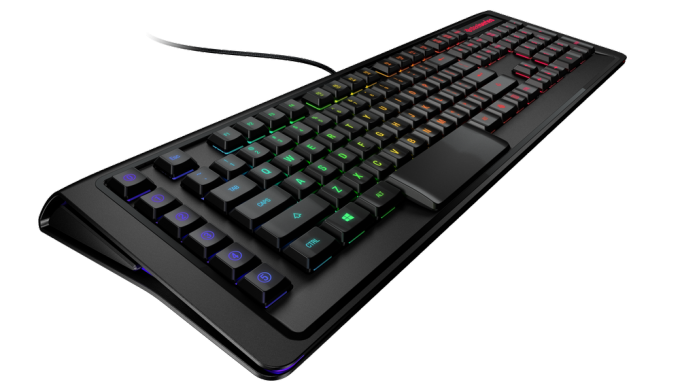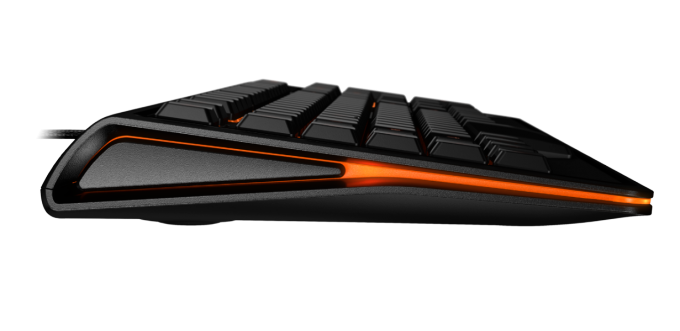- Qualcomm Launches Snapdragon 4 Gen 2 Mobile Platform
- AMD Launches Ryzen PRO 7000 Series Mobile & Desktop Platform
- Intel Launches Sleek Single-Slot Arc Pro A60 Workstation Graphics Card
- NVIDIA Announces Latest Ada Lovelace Additions: GeForce RTX 4060 Ti & RTX 4060
- Maxon Redshift With AMD Radeon GPU Rendering Support Now Available
SteelSeries Apex M800 Illuminated Mechanical Gaming Keyboard Review

SteelSeries has always been a heavy hitter in the world of peripherals. With a slew of highly touted mice, keyboards, and headsets, it looks to take things to the next level with the Apex M800 illuminated gaming keyboard. Does it have another winner on its hands, or are thousands of gamer nerds wrong? Read on to find out.
Page 3 – Final Thoughts
As mentioned before, whether or not you’ll like the QS1 switches comes down to personal preference. Long time Cherry MX switch users will likely notice a difference with the QS1 switches, but I didn’t since I’m coming over from the original Apex keyboard as my daily driver. The short throw combined with the low actuation force makes for fast keystrokes and less fatigue. In case you’re still not convinced, the retail box for the M800 allows prospective buyers to test out the keys before heading to the checkout. This is a great way to figure out if the feel of the QS1 switch is right for them.
When it comes to illumination, the sky’s the limit. Kicking off one of the preconfigured lighting templates, such as Horizontal Wave, or RainbowFeline (a bonus Pop Tart to SteelSeries for that one <3!) shows off just how crisp and bright the LEDs on the M800 are. The illumination customization options are out of this world as well, with specific keys setup to use alongside in-game cooldown timers being a personal favourite.
All-in-all, usability of the M800 is top-notch. It’s rugged and well-built; the returning USB hub is a nice feature for some fast and dirty peripheral connectivity or device charging; swapping out the included rubber pads for the thicker ones give the M800 a more aggressive profile that some might be more accustomed to; and the SteelSeries Engine 3 software, which receives regular updates is lightweight, easy to use, and allows for easy customization of the all keys.
Over the years I’ve had a few discussions with other editors here at Techgage that bordered on nerd rage about how I didn’t like mechanical keyboards. They’re noisy, heavy, and expensive, and for the most part, these three points ring true for the M800, but let’s address each of them individually.
There’s more noise generated with the M800 when compared to membrane keyboards, however the amount of noise seems much less than with other mechanical planks. This makes perfect sense if you were to think of using a mechanical switch in the same way as driving a car. The further you drive, the faster the car can go, but the more abrupt the stop. The drive is the travel distance, the speed is the actuation force required, and the stop is when the key bottoms out. The QS1 switches providing a shorter drive at a fast speed, but with an easier stop, which for me translated into less clickity clack while typing.
The build quality on the Apex M800 is fantastic, and it has some serious heft that gives it a quality feel that has to be experienced in person to truly appreciate. While it doesn’t have the added ruggedness of an aluminum outer chassis like some of competing models, the M800 is far from weak. There’s no squeaky plastic shell like those found on lower-end keyboards, and very little side to side motion in the key caps. Yes, the keyboard is heavier, which means a little more lugging if you take your gaming gear to LAN parties, but it should bode well for the durability of the keyboard as a whole.
When it comes to the cost of the M800, it should come as no surprise that a flagship model commands a flagship price. At ~$180 USD, this keyboard might be out of reach of the average gamer, however if being an adult has taught me anything, it’s that investing over the long haul is better than an immediate return. The average lifespan of a membrane key is about 5 million presses based on what I’ve read on various sites. Cherry MX switches, which are arguably the most popular, are good for around 50 million, while SteelSeries has the QS1 switch rated for 60 million presses. If we take a traditional $50 membrane keyboard, and if these numbers are even remotely accurate, you’d end up burning through 12 of them in order to match the lifespan of the M800; not to mention you’d spend $600!
So, is the Apex M800 illuminated gaming keyboard worth the extra noise, clunkiness, and cost? Yes, yes, and yes to all points. This long time mechanical keyboard hold out has now seen the light and after using the M800 for about a month and then switching back to the original Apex 350, which is certainly no slouch, I can honestly say that the differences are too stark to go back.
Pros
- QS1 switch improves upon the Cherry MX Red switch.
- Key illumination is bright and full with no blacked out areas.
- Nearly endless keybinding and illumination customization options.
- Solid construction and rugged design.
- SteelSeries Engine 3 continues to provide a user friendly experience.
Cons
- Large price tag may put it out of reach of some.

SteelSeries M800 Illuminated Gaming Keyboard
Support our efforts! With ad revenue at an all-time low for written websites, we're relying more than ever on reader support to help us continue putting so much effort into this type of content. You can support us by becoming a Patron, or by using our Amazon shopping affiliate links listed through our articles. Thanks for your support!






